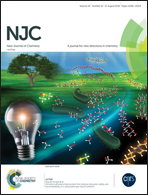Multiscale immobilized lipase for rapid separation and continuous catalysis†
Abstract
Enzyme–inorganic hybrid nanoflowers have drawn extensive research interest for enzyme immobilization owing to their enhanced enzymatic activity, high surface area, and excellent chemical stability. However, their low mechanical stability and challenging separation hinder their application. Herein, we report a facile and effective strategy to construct nanoflowers–PVA–chitosan composite (NPC) hydrogels that have excellent mechanical strength, high catalytic activity, and are easy to separate. Lipase–Cu3(PO4)2·3H2O nanoflowers were uniformly immobilized in hydrogel networks, and the substrate and the product can travel freely. The excellent mechanical properties of the hydrogels effectively protect the fragile nanoflowers from external stress, ensuring enzyme activity. Compared with free lipase (97.28 U g−1), NPC3 exhibited a higher enzymatic activity (146.12 U g−1) at 37 °C and pH 7.4. Furthermore, hydrogels as bulk materials can be processed into various physical forms, such as thin films and spheres. The product can easily flow out without the need for a separation process. It is expected that this immobilization method would have great potential in industrial catalysis.



 Please wait while we load your content...
Please wait while we load your content...